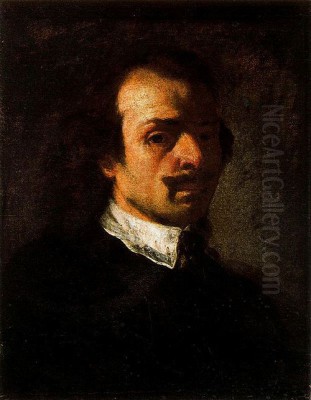
Pier Francesco Mola (1612-1666) stands as a significant yet sometimes overlooked figure in the vibrant tapestry of Italian Baroque art. Born in Coldrerio, then part of the Swiss Confederacy (now Ticino, Switzerland), Mola's destiny was tied to Rome, the artistic heart of the 17th century. His family relocated to the city when he was merely four years old, under the guidance of his father, Giovanni Battista Mola, an architect of some note. This early immersion in Rome's artistic and architectural environment undoubtedly shaped the young Mola's future path. Primarily active in Rome, his career was punctuated by formative periods spent in Northern Italy, significantly enriching his artistic vocabulary. Mola carved a niche for himself through his evocative religious paintings, atmospheric landscapes, and surprisingly sharp caricatures, demonstrating a versatility that defined his contribution to the Late Baroque period.
Early Life and Formative Travels
The move to Rome at a young age placed Pier Francesco Mola at the epicenter of artistic innovation. His father, Giovanni Battista Mola, worked on architectural projects in the city, providing a direct link to the world of design and construction, which Pier Francesco would later engage with himself, even creating designs for his father. His formal artistic training began under the tutelage of Giuseppe Cesari, better known as the Cavaliere d'Arpino, a prominent painter working in a late Mannerist style. This initial instruction provided Mola with a foundation in drawing and composition, though his artistic inclinations would soon lead him towards different influences.
Crucial to Mola's development were his extended stays in Northern Italy. He spent significant time away from Rome, notably between 1633-1640 and again from 1641-1647. During these years, he resided and worked primarily in Venice and Bologna, absorbing the distinct artistic traditions of these powerful centers. These travels were not mere interludes but transformative experiences that profoundly shaped his mature style. Exposure to the art of these regions provided a crucial counterpoint to the prevailing artistic currents in Rome.
Artistic Development and Synthesis of Influences
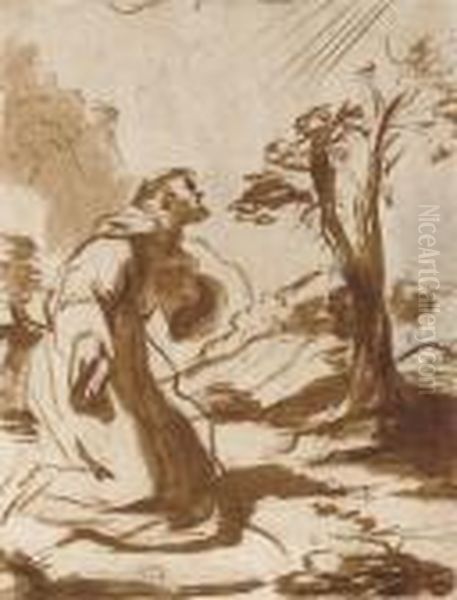
Mola's artistic style is best understood as a sophisticated synthesis of various influences, skillfully blended into a personal and recognizable manner. His time in Venice was particularly impactful. He immersed himself in the works of the great Venetian masters of the previous century, particularly Titian and Veronese. From them, he absorbed a love for rich, warm color, atmospheric effects, and a more painterly approach to brushwork, where visible strokes contribute to the texture and vitality of the surface. This Venetian sensibility would become a hallmark of his landscapes and the settings for his figural compositions.
In Bologna, Mola encountered the influential Bolognese school, which emphasized strong drawing, classical composition, and emotional clarity. He studied the works of Guercino, whose dramatic use of light and shadow and dynamic compositions left a mark. He was also influenced by Francesco Albani, another leading Bolognese classicist, with whom he may have studied more formally. Albani's graceful figures and idyllic landscapes offered a model of classical refinement.
Upon returning to Rome, Mola integrated these Northern Italian lessons with the Roman artistic environment. While influenced by the classical ideals promoted by artists like Andrea Sacchi, Mola's style retained a certain softness and naturalism derived from Venice and Guercino. His approach was often looser and more atmospheric than the sometimes rigid, theory-driven classicism of contemporaries like Nicolas Poussin, who was also active in Rome. While distinct from the dramatic intensity of early Baroque figures like Caravaggio, Mola certainly understood the power of chiaroscuro, employing contrasts of light and shadow to enhance mood and focus attention, albeit in a gentler manner than the Caravaggisti. His work offers a fascinating bridge, incorporating Venetian color, Bolognese structure, and Roman gravity.
Major Works and Commissions
Pier Francesco Mola's reputation was built on a series of significant works, including frescoes, altarpieces, and cabinet paintings. One of his most celebrated achievements is the fresco Joseph Making Himself Known to His Brethren, painted in 1657 for the Gallery of Alexander VII in the Quirinal Palace in Rome. This prestigious commission from the Pope himself marked a high point in Mola's career. The work is lauded for its dynamic composition, emotional depth, and skillful integration of figures within an expansive setting, showcasing his ability to handle large-scale narrative decoration. It is often considered his masterpiece.
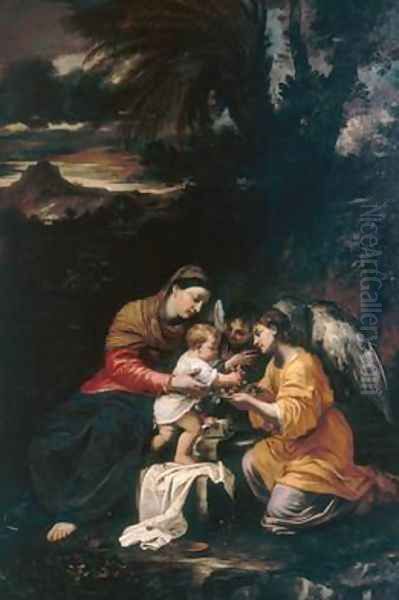
Another key work is Saint Francis Receiving the Stigmata, dating from around 1650-1655. This painting is notable not only for its sensitive portrayal of the saint's mystical experience, likely set within one of Mola's characteristic atmospheric landscapes, but also for its technique. Some accounts suggest this work, or a version of it, was executed on marble, demonstrating Mola's willingness to experiment with different supports and materials, adding a unique luminosity and permanence to the image.
Beyond these major commissions, Mola produced numerous paintings on religious and mythological themes, often on a smaller scale suitable for private collectors. Subjects drawn from the Bible, classical literature, and mythology frequently appear, typically featuring figures integrated into evocative landscapes. His skill as a draughtsman is evident in his preparatory studies, and he also distinguished himself as an etcher. His series of six etchings depicting The Flight into Egypt highlights his proficiency in this medium, allowing for wider dissemination of his compositions and showcasing his talent for narrative and landscape in graphic form.
Style and Technique: Landscape, Color, and Brushwork
Mola's artistic signature lies in his distinctive blend of stylistic elements. His landscapes are particularly noteworthy. Influenced by Venetian traditions and perhaps the burgeoning interest in landscape painting in Rome, seen also in the work of artists like Claude Lorrain and Salvator Rosa, Mola created scenes that were more than mere backdrops. They possess a lyrical, often slightly melancholic atmosphere, achieved through soft light, subtle color harmonies, and painterly brushwork. He often populated these landscapes with relatively small figures, emphasizing the relationship between humanity and the natural world.
His use of color reflects his Venetian studies, favoring warm earth tones, rich reds, and deep blues, applied with a sensitivity to light and shadow that creates depth and mood. His brushwork, while capable of precision, often tended towards a looser, more fluid application, particularly in landscapes and backgrounds. This contrasts with the highly finished surfaces favored by some of his classicizing contemporaries and imbues his work with a sense of immediacy and naturalness. Even in his more formally composed history paintings, this painterly quality often persists, softening outlines and adding texture.
Mola was also a gifted draughtsman. His drawings, whether preparatory studies for paintings or independent works, reveal a confident hand and a keen observational skill. This facility with line is particularly evident in his caricatures, which rely on swift, expressive strokes to capture character and satirical intent. His technical versatility extended to various media, including oil on canvas, fresco, drawing in various techniques (chalk, ink), etching, and even painting on stone supports like marble.
Caricatures and Satirical Insight
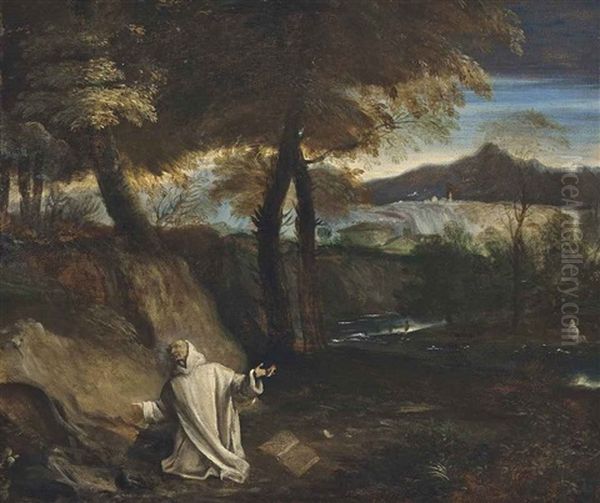
A fascinating and somewhat unusual aspect of Mola's output is his work as a caricaturist. In 17th-century Italy, caricature was developing as a genre, moving beyond the grotesque studies of Leonardo da Vinci towards more pointed social or personal commentary, famously practiced by Annibale Carracci and later Gian Lorenzo Bernini. Mola embraced this form with gusto, producing numerous drawings that exaggerated the features of individuals, including himself and prominent figures, reportedly even church officials.
These caricatures were likely intended for a more private audience and reveal a witty, observant, and perhaps critical side to Mola's personality. They are said to reflect his dissatisfaction with aspects of the art market and the complexities of artistic patronage. In an era where artists were heavily reliant on commissions from the Church and powerful families, these satirical sketches offered an outlet for personal expression and social commentary. They provide valuable insight into the artist's perspective on his world and the dynamics between artists and patrons in Baroque Rome. His skill in this genre positions him as an important early figure in the history of caricature.
Later Career, Recognition, and Challenges
Pier Francesco Mola achieved considerable recognition during his lifetime. His talent was acknowledged by his peers, leading to his election as Principe (President) of the prestigious Accademia di San Luca in Rome in 1662. This position placed him at the head of the city's official organization for artists. However, his tenure was brief; he resigned the following year, reportedly due to ill health, which seems to have plagued his later years.
Despite his artistic successes and high-profile commissions like the Quirinal fresco, Mola's later life was apparently not marked by great financial prosperity. Some accounts suggest he lived modestly and relied on the support of pupils and assistants in his workshop. While he continued to work, the volume of his output may have decreased in his final years. The exact reasons for his financial situation are unclear, but the competitive nature of the Roman art world and his health issues may have played a role. Nevertheless, his reputation endured, and his works were sought after by collectors.
Relationships with Contemporaries
Mola navigated the complex artistic landscape of Baroque Rome, interacting with numerous other artists. His style offered a distinct alternative to the High Baroque exuberance of Bernini or Pietro da Cortona, and the stricter classicism of Sacchi or Poussin. He seems to have had connections with artists who shared certain sensibilities. His association with Pietro Testa, another talented painter and etcher known for his complex allegorical subjects and evocative landscapes, suggests shared interests.
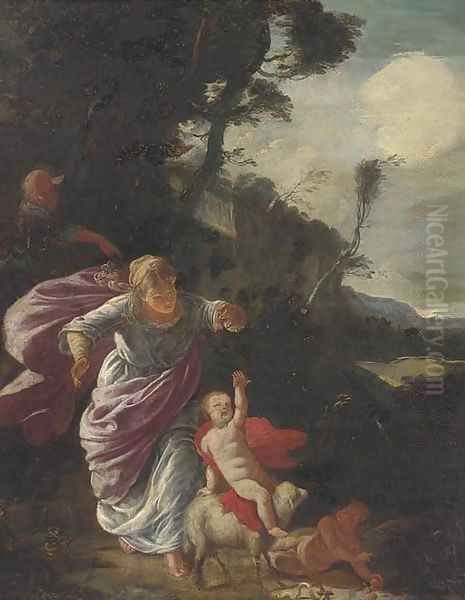
His collaboration with Giovanni Battista Castiglione, known as Il Grechetto, on certain projects points to professional networks and stylistic affinities, particularly in the integration of figures and animals within landscape settings. While his style differed from the dramatic intensity of Salvator Rosa, both artists shared an interest in expressive landscapes and perhaps a certain independent spirit. Mola's position within the Accademia di San Luca would have brought him into regular contact with the leading figures of the Roman art establishment, including later classicists like Carlo Maratta who came to dominate the scene towards the end of Mola's life.
Students and Lasting Legacy
Pier Francesco Mola's influence extended through his workshop and the students he trained. Among his known pupils were Jean-Baptiste Forest, who became a landscape painter, Antonio Gherardi, who developed a career as both a painter and an architect known for his inventive Baroque designs, and Giuseppe Bonati. Through them, aspects of Mola's style, particularly his approach to landscape and his painterly technique, were perpetuated.
Mola's works continued to be appreciated after his death. His paintings and drawings entered important private collections across Europe, including those of royalty and aristocracy in France, England, and the Netherlands, attesting to his international reputation. Today, his works are held in major museums worldwide, including the Louvre, the Prado, the National Gallery in London, the Getty Museum, and numerous Italian institutions.
Pier Francesco Mola remains a compelling figure in Baroque art history. He was an artist of synthesis, skillfully merging the coloristic warmth of Venice with the compositional strength of the Bolognese and Roman schools. He excelled in various genres, leaving behind masterful religious narratives, poetic landscapes, and insightful, witty caricatures. Though perhaps overshadowed at times by bigger names like Bernini or Caravaggio, Mola's unique artistic voice, his technical proficiency across different media, and his contribution to both landscape painting and the art of caricature secure his place as a significant and multifaceted master of the Italian Baroque. His art offers a nuanced perspective on the period, revealing a path that valued naturalism, atmosphere, and personal expression alongside the grander currents of Baroque classicism and drama.